Illustrated Report: Cell Biology, Structure, Function, and Genetics
VerifiedAdded on 2023/06/10
|23
|6485
|122
Report
AI Summary
This illustrated report provides a comprehensive overview of cell biology, starting with a comparison of living cells, including stem cells, and contrasting prokaryotic and eukaryotic cells, along with the impact of viruses. It delves into eukaryotic sub-cellular structures and organelles, explaining their functions and interactions. The report further discusses the role of the cell membrane in regulating nutrient intake and waste removal, how animal cells utilize nutrients for energy, and the function of nucleic acids in the cytoplasm and nucleus, including protein synthesis. Additionally, it covers the generation of specialized tissues from embryonic stem cells, the process of interphase, factors initiating cell division, and how each daughter cell receives the same genetic information. The report concludes with a comparative analysis of cancer cells and normal cells, highlighting key differences in their characteristics.

ILLUSTRATED REPORT
Paraphrase This Document
Need a fresh take? Get an instant paraphrase of this document with our AI Paraphraser
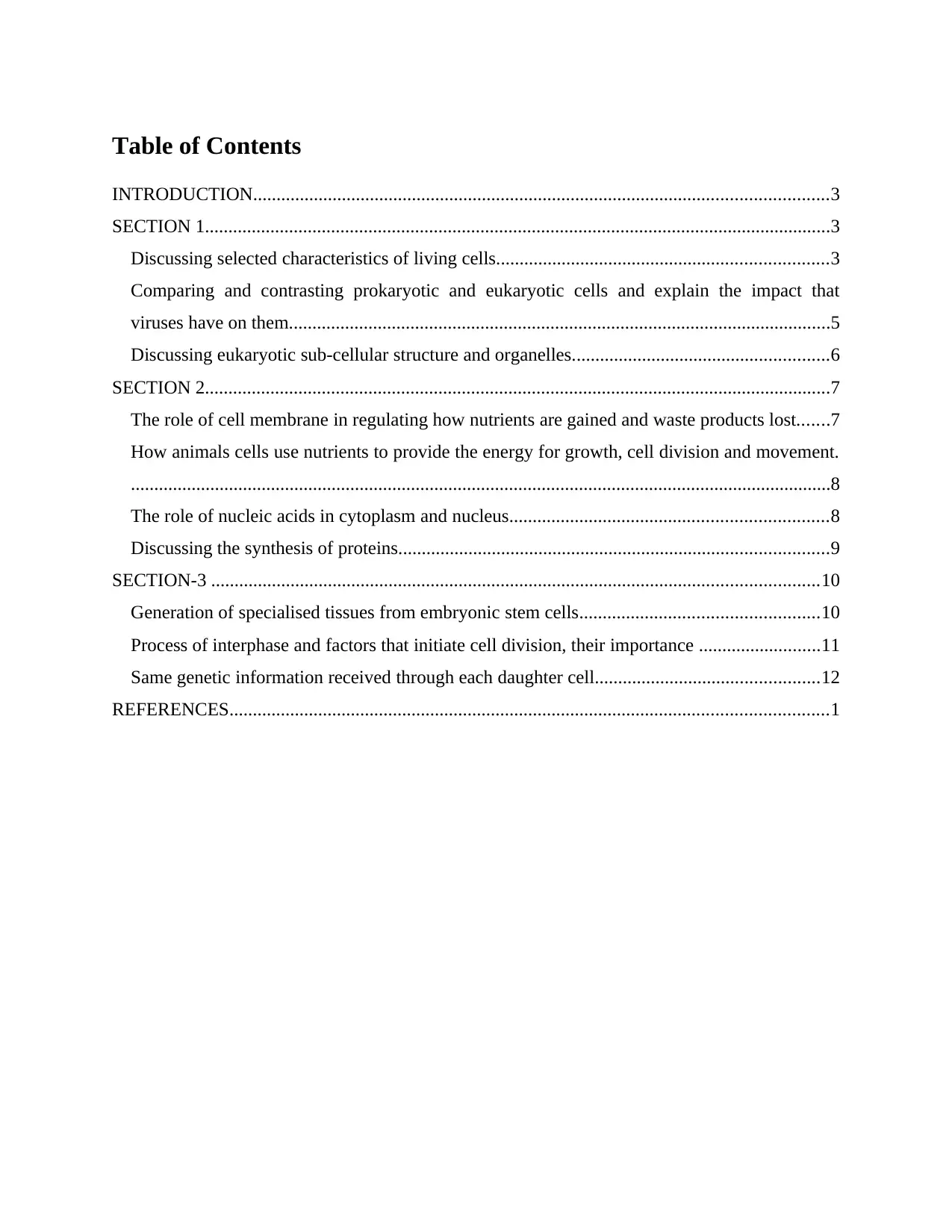
Table of Contents
INTRODUCTION...........................................................................................................................3
SECTION 1......................................................................................................................................3
Discussing selected characteristics of living cells.......................................................................3
Comparing and contrasting prokaryotic and eukaryotic cells and explain the impact that
viruses have on them....................................................................................................................5
Discussing eukaryotic sub-cellular structure and organelles.......................................................6
SECTION 2......................................................................................................................................7
The role of cell membrane in regulating how nutrients are gained and waste products lost.......7
How animals cells use nutrients to provide the energy for growth, cell division and movement.
......................................................................................................................................................8
The role of nucleic acids in cytoplasm and nucleus....................................................................8
Discussing the synthesis of proteins............................................................................................9
SECTION-3 ..................................................................................................................................10
Generation of specialised tissues from embryonic stem cells...................................................10
Process of interphase and factors that initiate cell division, their importance ..........................11
Same genetic information received through each daughter cell................................................12
REFERENCES................................................................................................................................1
INTRODUCTION...........................................................................................................................3
SECTION 1......................................................................................................................................3
Discussing selected characteristics of living cells.......................................................................3
Comparing and contrasting prokaryotic and eukaryotic cells and explain the impact that
viruses have on them....................................................................................................................5
Discussing eukaryotic sub-cellular structure and organelles.......................................................6
SECTION 2......................................................................................................................................7
The role of cell membrane in regulating how nutrients are gained and waste products lost.......7
How animals cells use nutrients to provide the energy for growth, cell division and movement.
......................................................................................................................................................8
The role of nucleic acids in cytoplasm and nucleus....................................................................8
Discussing the synthesis of proteins............................................................................................9
SECTION-3 ..................................................................................................................................10
Generation of specialised tissues from embryonic stem cells...................................................10
Process of interphase and factors that initiate cell division, their importance ..........................11
Same genetic information received through each daughter cell................................................12
REFERENCES................................................................................................................................1
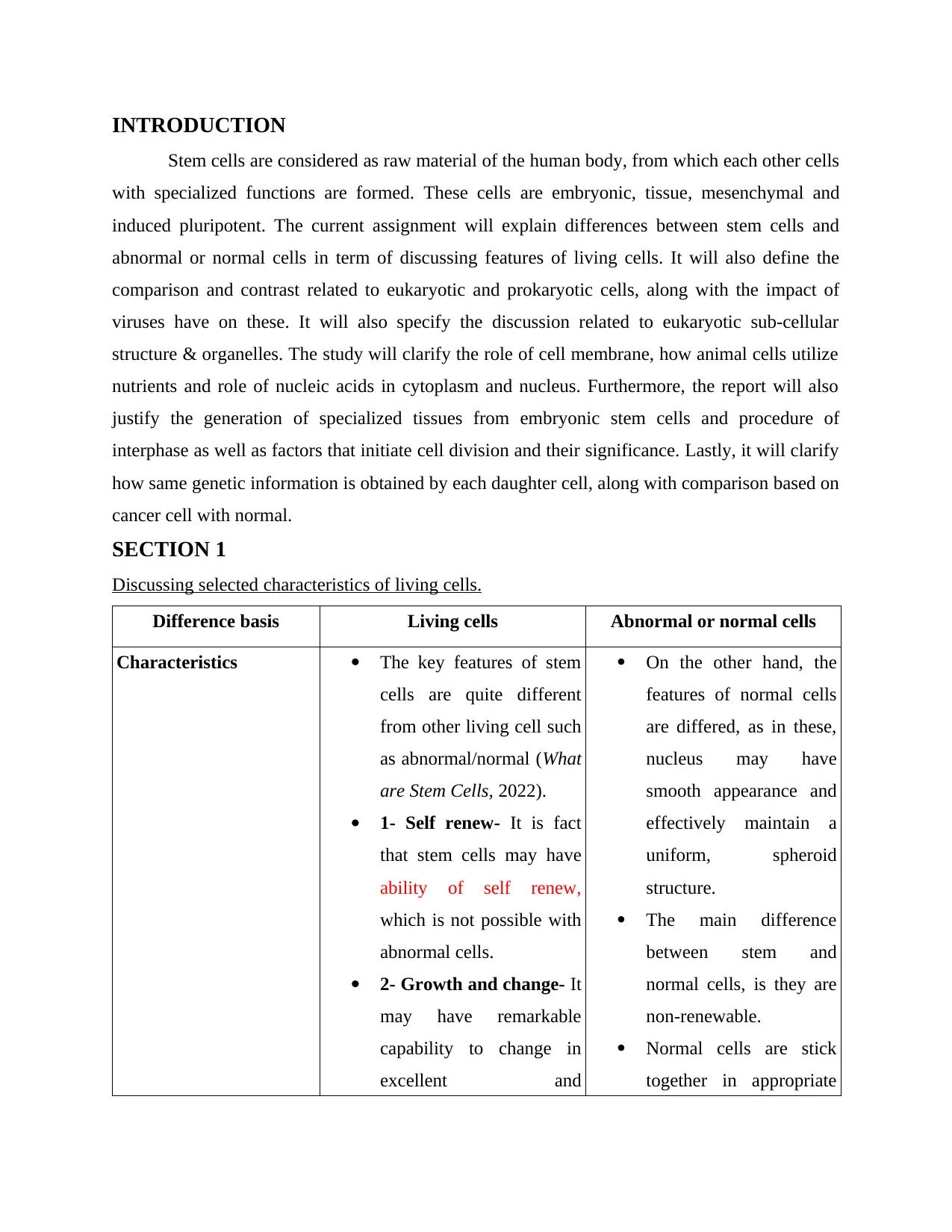
INTRODUCTION
Stem cells are considered as raw material of the human body, from which each other cells
with specialized functions are formed. These cells are embryonic, tissue, mesenchymal and
induced pluripotent. The current assignment will explain differences between stem cells and
abnormal or normal cells in term of discussing features of living cells. It will also define the
comparison and contrast related to eukaryotic and prokaryotic cells, along with the impact of
viruses have on these. It will also specify the discussion related to eukaryotic sub-cellular
structure & organelles. The study will clarify the role of cell membrane, how animal cells utilize
nutrients and role of nucleic acids in cytoplasm and nucleus. Furthermore, the report will also
justify the generation of specialized tissues from embryonic stem cells and procedure of
interphase as well as factors that initiate cell division and their significance. Lastly, it will clarify
how same genetic information is obtained by each daughter cell, along with comparison based on
cancer cell with normal.
SECTION 1
Discussing selected characteristics of living cells.
Difference basis Living cells Abnormal or normal cells
Characteristics The key features of stem
cells are quite different
from other living cell such
as abnormal/normal (What
are Stem Cells, 2022).
1- Self renew- It is fact
that stem cells may have
ability of self renew,
which is not possible with
abnormal cells.
2- Growth and change- It
may have remarkable
capability to change in
excellent and
On the other hand, the
features of normal cells
are differed, as in these,
nucleus may have
smooth appearance and
effectively maintain a
uniform, spheroid
structure.
The main difference
between stem and
normal cells, is they are
non-renewable.
Normal cells are stick
together in appropriate
Stem cells are considered as raw material of the human body, from which each other cells
with specialized functions are formed. These cells are embryonic, tissue, mesenchymal and
induced pluripotent. The current assignment will explain differences between stem cells and
abnormal or normal cells in term of discussing features of living cells. It will also define the
comparison and contrast related to eukaryotic and prokaryotic cells, along with the impact of
viruses have on these. It will also specify the discussion related to eukaryotic sub-cellular
structure & organelles. The study will clarify the role of cell membrane, how animal cells utilize
nutrients and role of nucleic acids in cytoplasm and nucleus. Furthermore, the report will also
justify the generation of specialized tissues from embryonic stem cells and procedure of
interphase as well as factors that initiate cell division and their significance. Lastly, it will clarify
how same genetic information is obtained by each daughter cell, along with comparison based on
cancer cell with normal.
SECTION 1
Discussing selected characteristics of living cells.
Difference basis Living cells Abnormal or normal cells
Characteristics The key features of stem
cells are quite different
from other living cell such
as abnormal/normal (What
are Stem Cells, 2022).
1- Self renew- It is fact
that stem cells may have
ability of self renew,
which is not possible with
abnormal cells.
2- Growth and change- It
may have remarkable
capability to change in
excellent and
On the other hand, the
features of normal cells
are differed, as in these,
nucleus may have
smooth appearance and
effectively maintain a
uniform, spheroid
structure.
The main difference
between stem and
normal cells, is they are
non-renewable.
Normal cells are stick
together in appropriate
⊘ This is a preview!⊘
Do you want full access?
Subscribe today to unlock all pages.

Trusted by 1+ million students worldwide
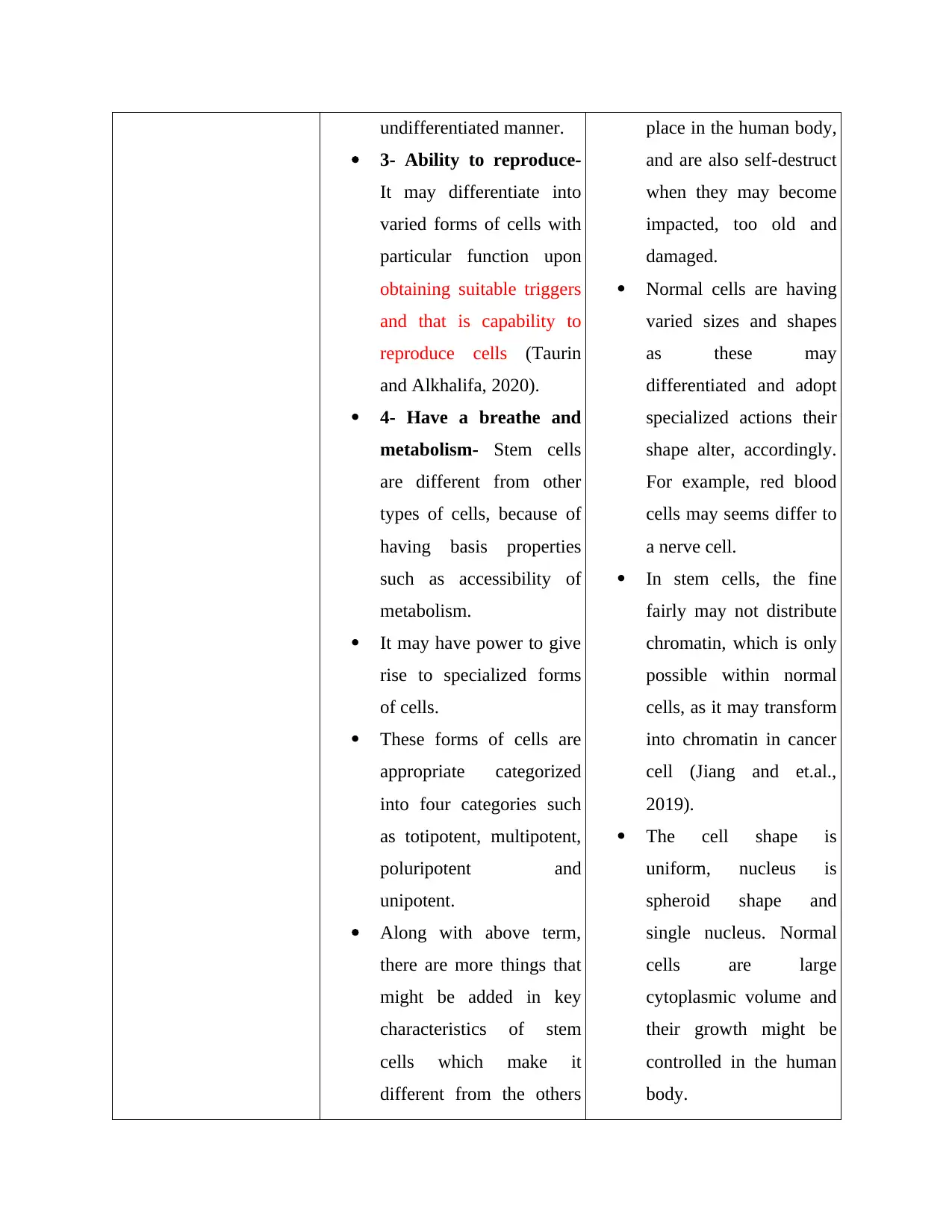
undifferentiated manner.
3- Ability to reproduce-
It may differentiate into
varied forms of cells with
particular function upon
obtaining suitable triggers
and that is capability to
reproduce cells (Taurin
and Alkhalifa, 2020).
4- Have a breathe and
metabolism- Stem cells
are different from other
types of cells, because of
having basis properties
such as accessibility of
metabolism.
It may have power to give
rise to specialized forms
of cells.
These forms of cells are
appropriate categorized
into four categories such
as totipotent, multipotent,
poluripotent and
unipotent.
Along with above term,
there are more things that
might be added in key
characteristics of stem
cells which make it
different from the others
place in the human body,
and are also self-destruct
when they may become
impacted, too old and
damaged.
Normal cells are having
varied sizes and shapes
as these may
differentiated and adopt
specialized actions their
shape alter, accordingly.
For example, red blood
cells may seems differ to
a nerve cell.
In stem cells, the fine
fairly may not distribute
chromatin, which is only
possible within normal
cells, as it may transform
into chromatin in cancer
cell (Jiang and et.al.,
2019).
The cell shape is
uniform, nucleus is
spheroid shape and
single nucleus. Normal
cells are large
cytoplasmic volume and
their growth might be
controlled in the human
body.
3- Ability to reproduce-
It may differentiate into
varied forms of cells with
particular function upon
obtaining suitable triggers
and that is capability to
reproduce cells (Taurin
and Alkhalifa, 2020).
4- Have a breathe and
metabolism- Stem cells
are different from other
types of cells, because of
having basis properties
such as accessibility of
metabolism.
It may have power to give
rise to specialized forms
of cells.
These forms of cells are
appropriate categorized
into four categories such
as totipotent, multipotent,
poluripotent and
unipotent.
Along with above term,
there are more things that
might be added in key
characteristics of stem
cells which make it
different from the others
place in the human body,
and are also self-destruct
when they may become
impacted, too old and
damaged.
Normal cells are having
varied sizes and shapes
as these may
differentiated and adopt
specialized actions their
shape alter, accordingly.
For example, red blood
cells may seems differ to
a nerve cell.
In stem cells, the fine
fairly may not distribute
chromatin, which is only
possible within normal
cells, as it may transform
into chromatin in cancer
cell (Jiang and et.al.,
2019).
The cell shape is
uniform, nucleus is
spheroid shape and
single nucleus. Normal
cells are large
cytoplasmic volume and
their growth might be
controlled in the human
body.
Paraphrase This Document
Need a fresh take? Get an instant paraphrase of this document with our AI Paraphraser
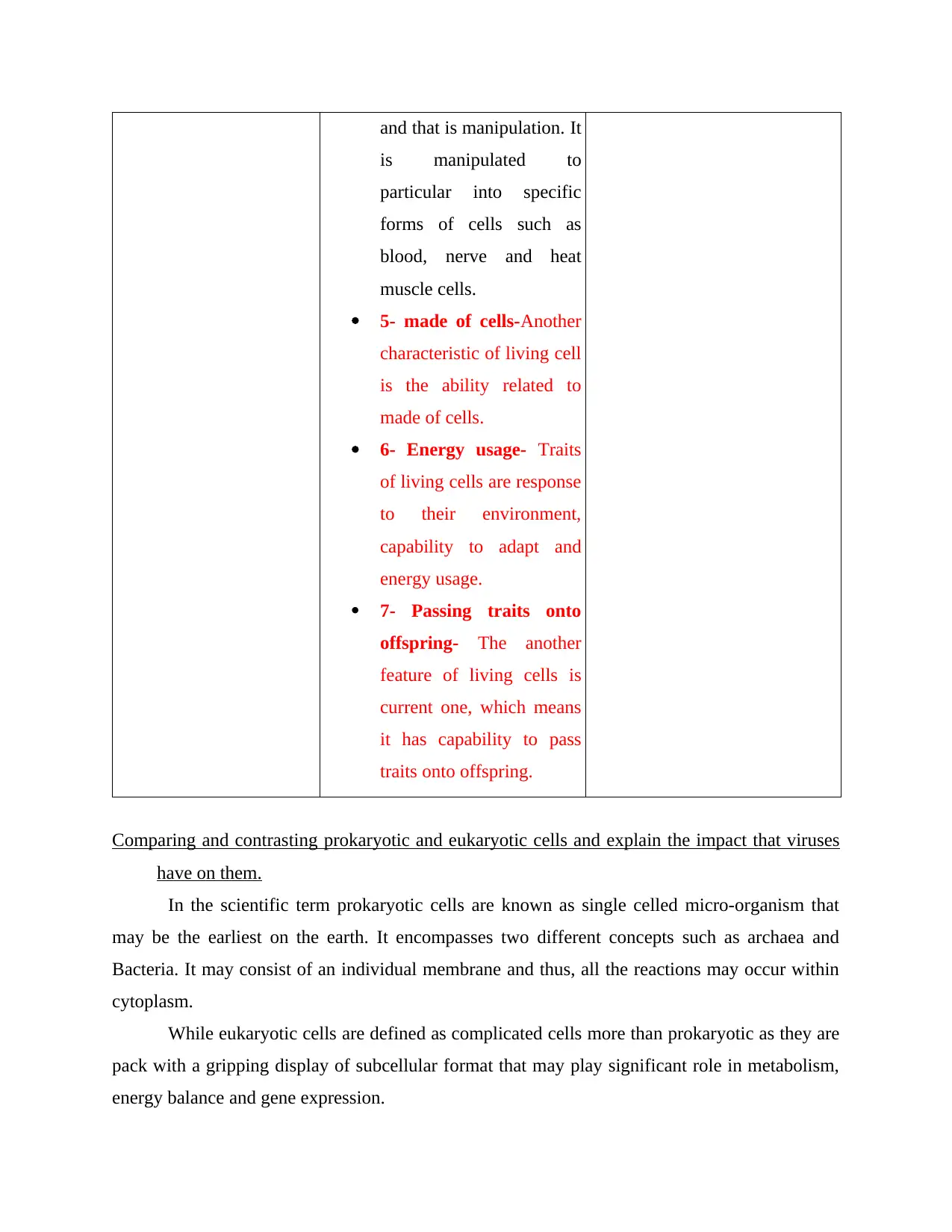
and that is manipulation. It
is manipulated to
particular into specific
forms of cells such as
blood, nerve and heat
muscle cells.
5- made of cells-Another
characteristic of living cell
is the ability related to
made of cells.
6- Energy usage- Traits
of living cells are response
to their environment,
capability to adapt and
energy usage.
7- Passing traits onto
offspring- The another
feature of living cells is
current one, which means
it has capability to pass
traits onto offspring.
Comparing and contrasting prokaryotic and eukaryotic cells and explain the impact that viruses
have on them.
In the scientific term prokaryotic cells are known as single celled micro-organism that
may be the earliest on the earth. It encompasses two different concepts such as archaea and
Bacteria. It may consist of an individual membrane and thus, all the reactions may occur within
cytoplasm.
While eukaryotic cells are defined as complicated cells more than prokaryotic as they are
pack with a gripping display of subcellular format that may play significant role in metabolism,
energy balance and gene expression.
is manipulated to
particular into specific
forms of cells such as
blood, nerve and heat
muscle cells.
5- made of cells-Another
characteristic of living cell
is the ability related to
made of cells.
6- Energy usage- Traits
of living cells are response
to their environment,
capability to adapt and
energy usage.
7- Passing traits onto
offspring- The another
feature of living cells is
current one, which means
it has capability to pass
traits onto offspring.
Comparing and contrasting prokaryotic and eukaryotic cells and explain the impact that viruses
have on them.
In the scientific term prokaryotic cells are known as single celled micro-organism that
may be the earliest on the earth. It encompasses two different concepts such as archaea and
Bacteria. It may consist of an individual membrane and thus, all the reactions may occur within
cytoplasm.
While eukaryotic cells are defined as complicated cells more than prokaryotic as they are
pack with a gripping display of subcellular format that may play significant role in metabolism,
energy balance and gene expression.
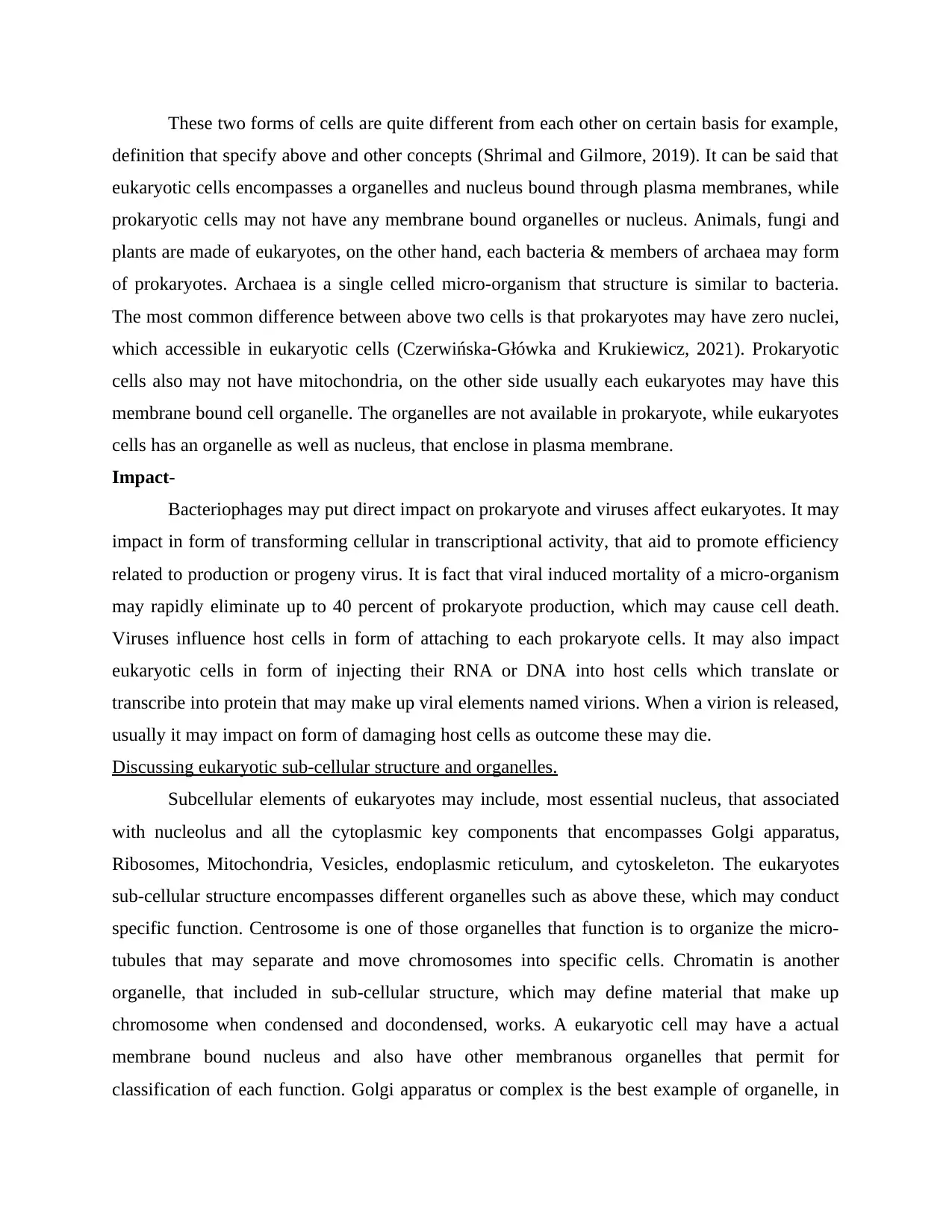
These two forms of cells are quite different from each other on certain basis for example,
definition that specify above and other concepts (Shrimal and Gilmore, 2019). It can be said that
eukaryotic cells encompasses a organelles and nucleus bound through plasma membranes, while
prokaryotic cells may not have any membrane bound organelles or nucleus. Animals, fungi and
plants are made of eukaryotes, on the other hand, each bacteria & members of archaea may form
of prokaryotes. Archaea is a single celled micro-organism that structure is similar to bacteria.
The most common difference between above two cells is that prokaryotes may have zero nuclei,
which accessible in eukaryotic cells (Czerwińska-Główka and Krukiewicz, 2021). Prokaryotic
cells also may not have mitochondria, on the other side usually each eukaryotes may have this
membrane bound cell organelle. The organelles are not available in prokaryote, while eukaryotes
cells has an organelle as well as nucleus, that enclose in plasma membrane.
Impact-
Bacteriophages may put direct impact on prokaryote and viruses affect eukaryotes. It may
impact in form of transforming cellular in transcriptional activity, that aid to promote efficiency
related to production or progeny virus. It is fact that viral induced mortality of a micro-organism
may rapidly eliminate up to 40 percent of prokaryote production, which may cause cell death.
Viruses influence host cells in form of attaching to each prokaryote cells. It may also impact
eukaryotic cells in form of injecting their RNA or DNA into host cells which translate or
transcribe into protein that may make up viral elements named virions. When a virion is released,
usually it may impact on form of damaging host cells as outcome these may die.
Discussing eukaryotic sub-cellular structure and organelles.
Subcellular elements of eukaryotes may include, most essential nucleus, that associated
with nucleolus and all the cytoplasmic key components that encompasses Golgi apparatus,
Ribosomes, Mitochondria, Vesicles, endoplasmic reticulum, and cytoskeleton. The eukaryotes
sub-cellular structure encompasses different organelles such as above these, which may conduct
specific function. Centrosome is one of those organelles that function is to organize the micro-
tubules that may separate and move chromosomes into specific cells. Chromatin is another
organelle, that included in sub-cellular structure, which may define material that make up
chromosome when condensed and docondensed, works. A eukaryotic cell may have a actual
membrane bound nucleus and also have other membranous organelles that permit for
classification of each function. Golgi apparatus or complex is the best example of organelle, in
definition that specify above and other concepts (Shrimal and Gilmore, 2019). It can be said that
eukaryotic cells encompasses a organelles and nucleus bound through plasma membranes, while
prokaryotic cells may not have any membrane bound organelles or nucleus. Animals, fungi and
plants are made of eukaryotes, on the other hand, each bacteria & members of archaea may form
of prokaryotes. Archaea is a single celled micro-organism that structure is similar to bacteria.
The most common difference between above two cells is that prokaryotes may have zero nuclei,
which accessible in eukaryotic cells (Czerwińska-Główka and Krukiewicz, 2021). Prokaryotic
cells also may not have mitochondria, on the other side usually each eukaryotes may have this
membrane bound cell organelle. The organelles are not available in prokaryote, while eukaryotes
cells has an organelle as well as nucleus, that enclose in plasma membrane.
Impact-
Bacteriophages may put direct impact on prokaryote and viruses affect eukaryotes. It may
impact in form of transforming cellular in transcriptional activity, that aid to promote efficiency
related to production or progeny virus. It is fact that viral induced mortality of a micro-organism
may rapidly eliminate up to 40 percent of prokaryote production, which may cause cell death.
Viruses influence host cells in form of attaching to each prokaryote cells. It may also impact
eukaryotic cells in form of injecting their RNA or DNA into host cells which translate or
transcribe into protein that may make up viral elements named virions. When a virion is released,
usually it may impact on form of damaging host cells as outcome these may die.
Discussing eukaryotic sub-cellular structure and organelles.
Subcellular elements of eukaryotes may include, most essential nucleus, that associated
with nucleolus and all the cytoplasmic key components that encompasses Golgi apparatus,
Ribosomes, Mitochondria, Vesicles, endoplasmic reticulum, and cytoskeleton. The eukaryotes
sub-cellular structure encompasses different organelles such as above these, which may conduct
specific function. Centrosome is one of those organelles that function is to organize the micro-
tubules that may separate and move chromosomes into specific cells. Chromatin is another
organelle, that included in sub-cellular structure, which may define material that make up
chromosome when condensed and docondensed, works. A eukaryotic cell may have a actual
membrane bound nucleus and also have other membranous organelles that permit for
classification of each function. Golgi apparatus or complex is the best example of organelle, in
⊘ This is a preview!⊘
Do you want full access?
Subscribe today to unlock all pages.

Trusted by 1+ million students worldwide
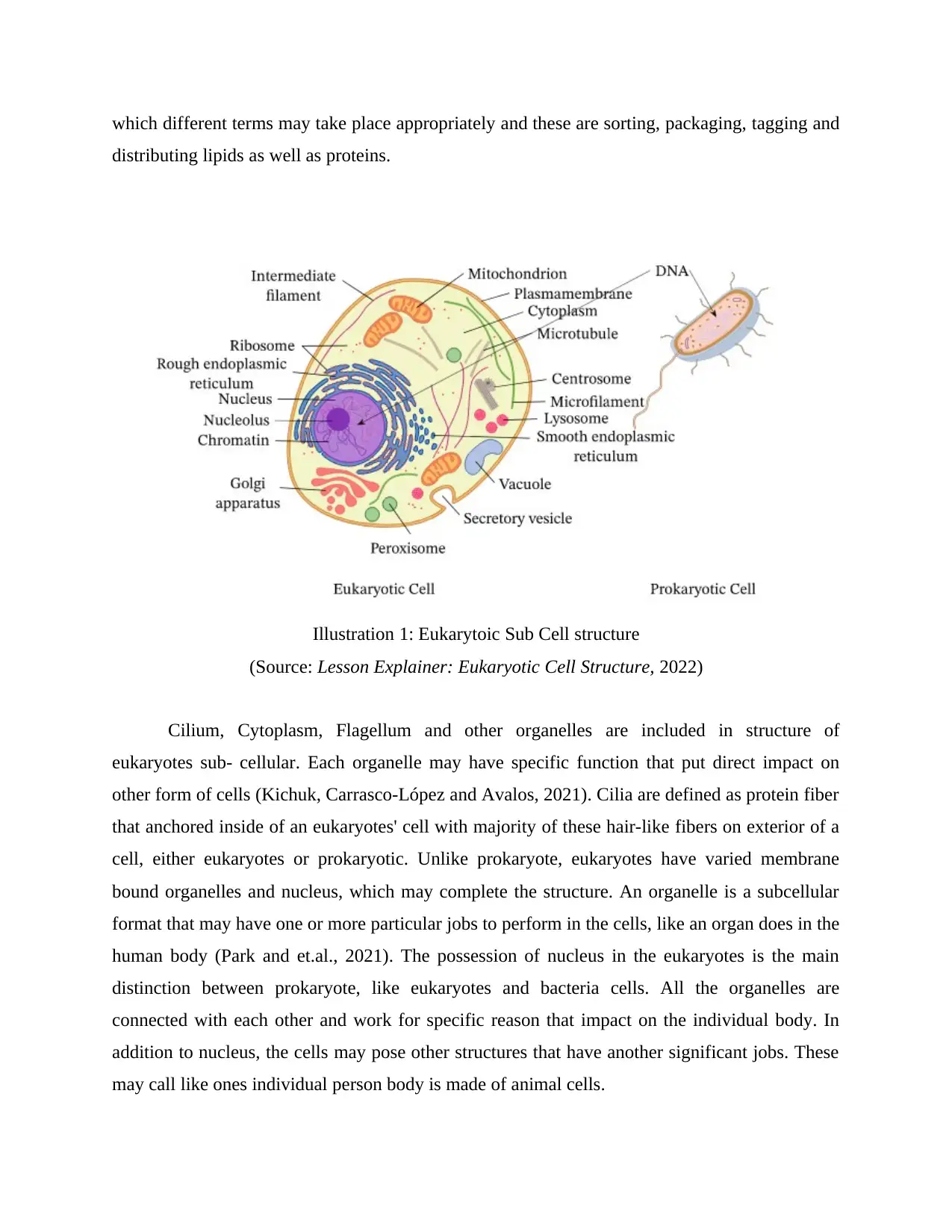
which different terms may take place appropriately and these are sorting, packaging, tagging and
distributing lipids as well as proteins.
Cilium, Cytoplasm, Flagellum and other organelles are included in structure of
eukaryotes sub- cellular. Each organelle may have specific function that put direct impact on
other form of cells (Kichuk, Carrasco‐López and Avalos, 2021). Cilia are defined as protein fiber
that anchored inside of an eukaryotes' cell with majority of these hair-like fibers on exterior of a
cell, either eukaryotes or prokaryotic. Unlike prokaryote, eukaryotes have varied membrane
bound organelles and nucleus, which may complete the structure. An organelle is a subcellular
format that may have one or more particular jobs to perform in the cells, like an organ does in the
human body (Park and et.al., 2021). The possession of nucleus in the eukaryotes is the main
distinction between prokaryote, like eukaryotes and bacteria cells. All the organelles are
connected with each other and work for specific reason that impact on the individual body. In
addition to nucleus, the cells may pose other structures that have another significant jobs. These
may call like ones individual person body is made of animal cells.
Illustration 1: Eukarytoic Sub Cell structure
(Source: Lesson Explainer: Eukaryotic Cell Structure, 2022)
distributing lipids as well as proteins.
Cilium, Cytoplasm, Flagellum and other organelles are included in structure of
eukaryotes sub- cellular. Each organelle may have specific function that put direct impact on
other form of cells (Kichuk, Carrasco‐López and Avalos, 2021). Cilia are defined as protein fiber
that anchored inside of an eukaryotes' cell with majority of these hair-like fibers on exterior of a
cell, either eukaryotes or prokaryotic. Unlike prokaryote, eukaryotes have varied membrane
bound organelles and nucleus, which may complete the structure. An organelle is a subcellular
format that may have one or more particular jobs to perform in the cells, like an organ does in the
human body (Park and et.al., 2021). The possession of nucleus in the eukaryotes is the main
distinction between prokaryote, like eukaryotes and bacteria cells. All the organelles are
connected with each other and work for specific reason that impact on the individual body. In
addition to nucleus, the cells may pose other structures that have another significant jobs. These
may call like ones individual person body is made of animal cells.
Illustration 1: Eukarytoic Sub Cell structure
(Source: Lesson Explainer: Eukaryotic Cell Structure, 2022)
Paraphrase This Document
Need a fresh take? Get an instant paraphrase of this document with our AI Paraphraser
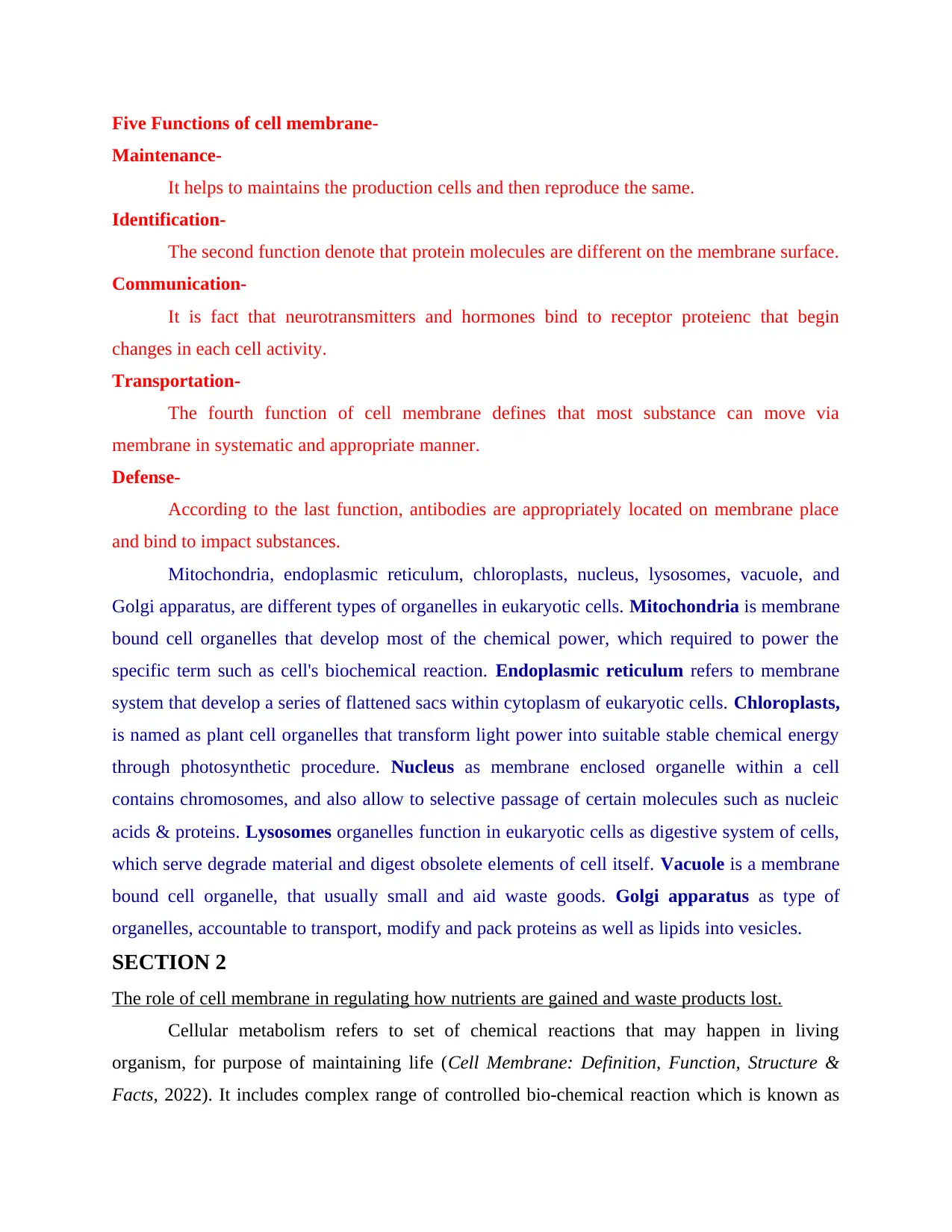
Five Functions of cell membrane-
Maintenance-
It helps to maintains the production cells and then reproduce the same.
Identification-
The second function denote that protein molecules are different on the membrane surface.
Communication-
It is fact that neurotransmitters and hormones bind to receptor proteienc that begin
changes in each cell activity.
Transportation-
The fourth function of cell membrane defines that most substance can move via
membrane in systematic and appropriate manner.
Defense-
According to the last function, antibodies are appropriately located on membrane place
and bind to impact substances.
Mitochondria, endoplasmic reticulum, chloroplasts, nucleus, lysosomes, vacuole, and
Golgi apparatus, are different types of organelles in eukaryotic cells. Mitochondria is membrane
bound cell organelles that develop most of the chemical power, which required to power the
specific term such as cell's biochemical reaction. Endoplasmic reticulum refers to membrane
system that develop a series of flattened sacs within cytoplasm of eukaryotic cells. Chloroplasts,
is named as plant cell organelles that transform light power into suitable stable chemical energy
through photosynthetic procedure. Nucleus as membrane enclosed organelle within a cell
contains chromosomes, and also allow to selective passage of certain molecules such as nucleic
acids & proteins. Lysosomes organelles function in eukaryotic cells as digestive system of cells,
which serve degrade material and digest obsolete elements of cell itself. Vacuole is a membrane
bound cell organelle, that usually small and aid waste goods. Golgi apparatus as type of
organelles, accountable to transport, modify and pack proteins as well as lipids into vesicles.
SECTION 2
The role of cell membrane in regulating how nutrients are gained and waste products lost.
Cellular metabolism refers to set of chemical reactions that may happen in living
organism, for purpose of maintaining life (Cell Membrane: Definition, Function, Structure &
Facts, 2022). It includes complex range of controlled bio-chemical reaction which is known as
Maintenance-
It helps to maintains the production cells and then reproduce the same.
Identification-
The second function denote that protein molecules are different on the membrane surface.
Communication-
It is fact that neurotransmitters and hormones bind to receptor proteienc that begin
changes in each cell activity.
Transportation-
The fourth function of cell membrane defines that most substance can move via
membrane in systematic and appropriate manner.
Defense-
According to the last function, antibodies are appropriately located on membrane place
and bind to impact substances.
Mitochondria, endoplasmic reticulum, chloroplasts, nucleus, lysosomes, vacuole, and
Golgi apparatus, are different types of organelles in eukaryotic cells. Mitochondria is membrane
bound cell organelles that develop most of the chemical power, which required to power the
specific term such as cell's biochemical reaction. Endoplasmic reticulum refers to membrane
system that develop a series of flattened sacs within cytoplasm of eukaryotic cells. Chloroplasts,
is named as plant cell organelles that transform light power into suitable stable chemical energy
through photosynthetic procedure. Nucleus as membrane enclosed organelle within a cell
contains chromosomes, and also allow to selective passage of certain molecules such as nucleic
acids & proteins. Lysosomes organelles function in eukaryotic cells as digestive system of cells,
which serve degrade material and digest obsolete elements of cell itself. Vacuole is a membrane
bound cell organelle, that usually small and aid waste goods. Golgi apparatus as type of
organelles, accountable to transport, modify and pack proteins as well as lipids into vesicles.
SECTION 2
The role of cell membrane in regulating how nutrients are gained and waste products lost.
Cellular metabolism refers to set of chemical reactions that may happen in living
organism, for purpose of maintaining life (Cell Membrane: Definition, Function, Structure &
Facts, 2022). It includes complex range of controlled bio-chemical reaction which is known as
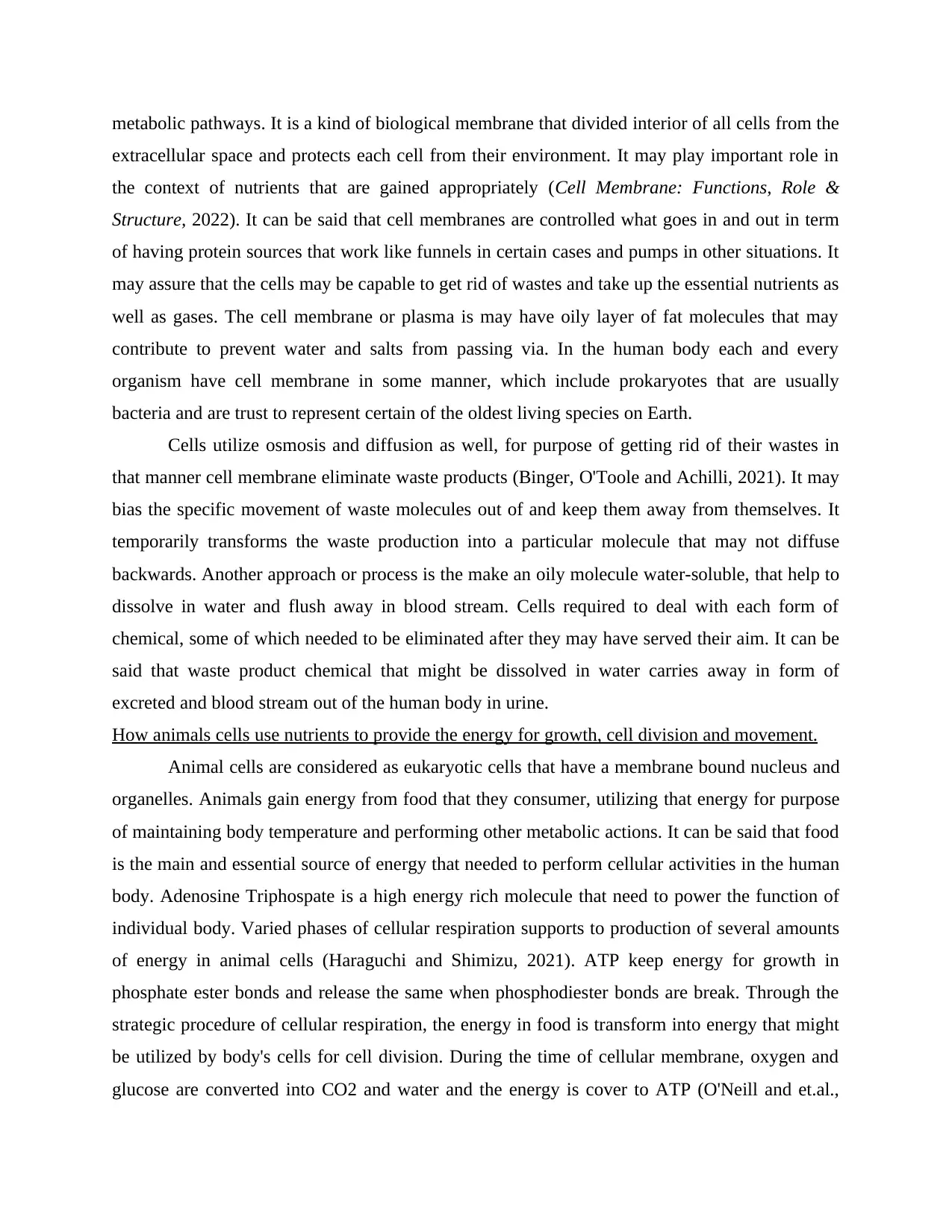
metabolic pathways. It is a kind of biological membrane that divided interior of all cells from the
extracellular space and protects each cell from their environment. It may play important role in
the context of nutrients that are gained appropriately (Cell Membrane: Functions, Role &
Structure, 2022). It can be said that cell membranes are controlled what goes in and out in term
of having protein sources that work like funnels in certain cases and pumps in other situations. It
may assure that the cells may be capable to get rid of wastes and take up the essential nutrients as
well as gases. The cell membrane or plasma is may have oily layer of fat molecules that may
contribute to prevent water and salts from passing via. In the human body each and every
organism have cell membrane in some manner, which include prokaryotes that are usually
bacteria and are trust to represent certain of the oldest living species on Earth.
Cells utilize osmosis and diffusion as well, for purpose of getting rid of their wastes in
that manner cell membrane eliminate waste products (Binger, O'Toole and Achilli, 2021). It may
bias the specific movement of waste molecules out of and keep them away from themselves. It
temporarily transforms the waste production into a particular molecule that may not diffuse
backwards. Another approach or process is the make an oily molecule water-soluble, that help to
dissolve in water and flush away in blood stream. Cells required to deal with each form of
chemical, some of which needed to be eliminated after they may have served their aim. It can be
said that waste product chemical that might be dissolved in water carries away in form of
excreted and blood stream out of the human body in urine.
How animals cells use nutrients to provide the energy for growth, cell division and movement.
Animal cells are considered as eukaryotic cells that have a membrane bound nucleus and
organelles. Animals gain energy from food that they consumer, utilizing that energy for purpose
of maintaining body temperature and performing other metabolic actions. It can be said that food
is the main and essential source of energy that needed to perform cellular activities in the human
body. Adenosine Triphospate is a high energy rich molecule that need to power the function of
individual body. Varied phases of cellular respiration supports to production of several amounts
of energy in animal cells (Haraguchi and Shimizu, 2021). ATP keep energy for growth in
phosphate ester bonds and release the same when phosphodiester bonds are break. Through the
strategic procedure of cellular respiration, the energy in food is transform into energy that might
be utilized by body's cells for cell division. During the time of cellular membrane, oxygen and
glucose are converted into CO2 and water and the energy is cover to ATP (O'Neill and et.al.,
extracellular space and protects each cell from their environment. It may play important role in
the context of nutrients that are gained appropriately (Cell Membrane: Functions, Role &
Structure, 2022). It can be said that cell membranes are controlled what goes in and out in term
of having protein sources that work like funnels in certain cases and pumps in other situations. It
may assure that the cells may be capable to get rid of wastes and take up the essential nutrients as
well as gases. The cell membrane or plasma is may have oily layer of fat molecules that may
contribute to prevent water and salts from passing via. In the human body each and every
organism have cell membrane in some manner, which include prokaryotes that are usually
bacteria and are trust to represent certain of the oldest living species on Earth.
Cells utilize osmosis and diffusion as well, for purpose of getting rid of their wastes in
that manner cell membrane eliminate waste products (Binger, O'Toole and Achilli, 2021). It may
bias the specific movement of waste molecules out of and keep them away from themselves. It
temporarily transforms the waste production into a particular molecule that may not diffuse
backwards. Another approach or process is the make an oily molecule water-soluble, that help to
dissolve in water and flush away in blood stream. Cells required to deal with each form of
chemical, some of which needed to be eliminated after they may have served their aim. It can be
said that waste product chemical that might be dissolved in water carries away in form of
excreted and blood stream out of the human body in urine.
How animals cells use nutrients to provide the energy for growth, cell division and movement.
Animal cells are considered as eukaryotic cells that have a membrane bound nucleus and
organelles. Animals gain energy from food that they consumer, utilizing that energy for purpose
of maintaining body temperature and performing other metabolic actions. It can be said that food
is the main and essential source of energy that needed to perform cellular activities in the human
body. Adenosine Triphospate is a high energy rich molecule that need to power the function of
individual body. Varied phases of cellular respiration supports to production of several amounts
of energy in animal cells (Haraguchi and Shimizu, 2021). ATP keep energy for growth in
phosphate ester bonds and release the same when phosphodiester bonds are break. Through the
strategic procedure of cellular respiration, the energy in food is transform into energy that might
be utilized by body's cells for cell division. During the time of cellular membrane, oxygen and
glucose are converted into CO2 and water and the energy is cover to ATP (O'Neill and et.al.,
⊘ This is a preview!⊘
Do you want full access?
Subscribe today to unlock all pages.

Trusted by 1+ million students worldwide
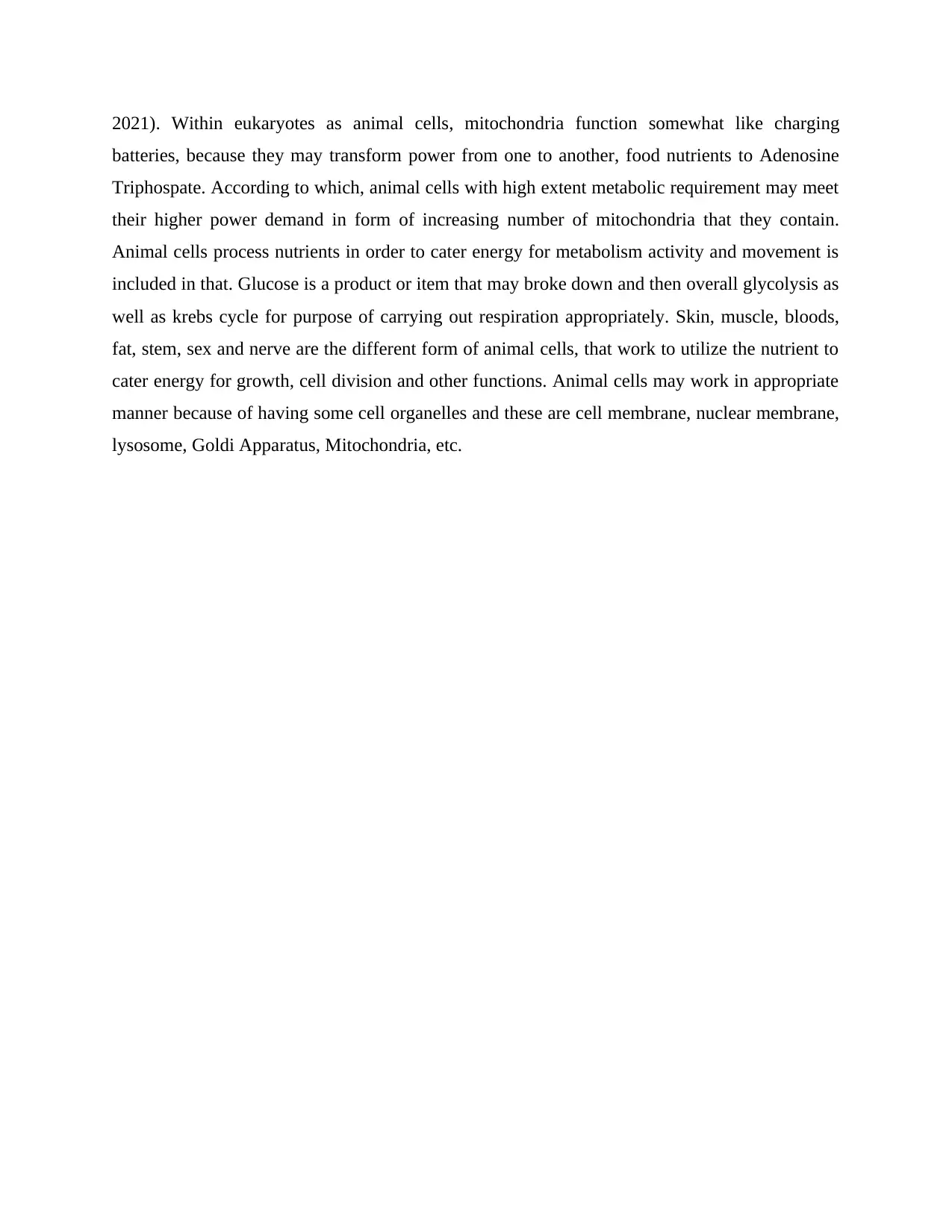
2021). Within eukaryotes as animal cells, mitochondria function somewhat like charging
batteries, because they may transform power from one to another, food nutrients to Adenosine
Triphospate. According to which, animal cells with high extent metabolic requirement may meet
their higher power demand in form of increasing number of mitochondria that they contain.
Animal cells process nutrients in order to cater energy for metabolism activity and movement is
included in that. Glucose is a product or item that may broke down and then overall glycolysis as
well as krebs cycle for purpose of carrying out respiration appropriately. Skin, muscle, bloods,
fat, stem, sex and nerve are the different form of animal cells, that work to utilize the nutrient to
cater energy for growth, cell division and other functions. Animal cells may work in appropriate
manner because of having some cell organelles and these are cell membrane, nuclear membrane,
lysosome, Goldi Apparatus, Mitochondria, etc.
batteries, because they may transform power from one to another, food nutrients to Adenosine
Triphospate. According to which, animal cells with high extent metabolic requirement may meet
their higher power demand in form of increasing number of mitochondria that they contain.
Animal cells process nutrients in order to cater energy for metabolism activity and movement is
included in that. Glucose is a product or item that may broke down and then overall glycolysis as
well as krebs cycle for purpose of carrying out respiration appropriately. Skin, muscle, bloods,
fat, stem, sex and nerve are the different form of animal cells, that work to utilize the nutrient to
cater energy for growth, cell division and other functions. Animal cells may work in appropriate
manner because of having some cell organelles and these are cell membrane, nuclear membrane,
lysosome, Goldi Apparatus, Mitochondria, etc.
Paraphrase This Document
Need a fresh take? Get an instant paraphrase of this document with our AI Paraphraser
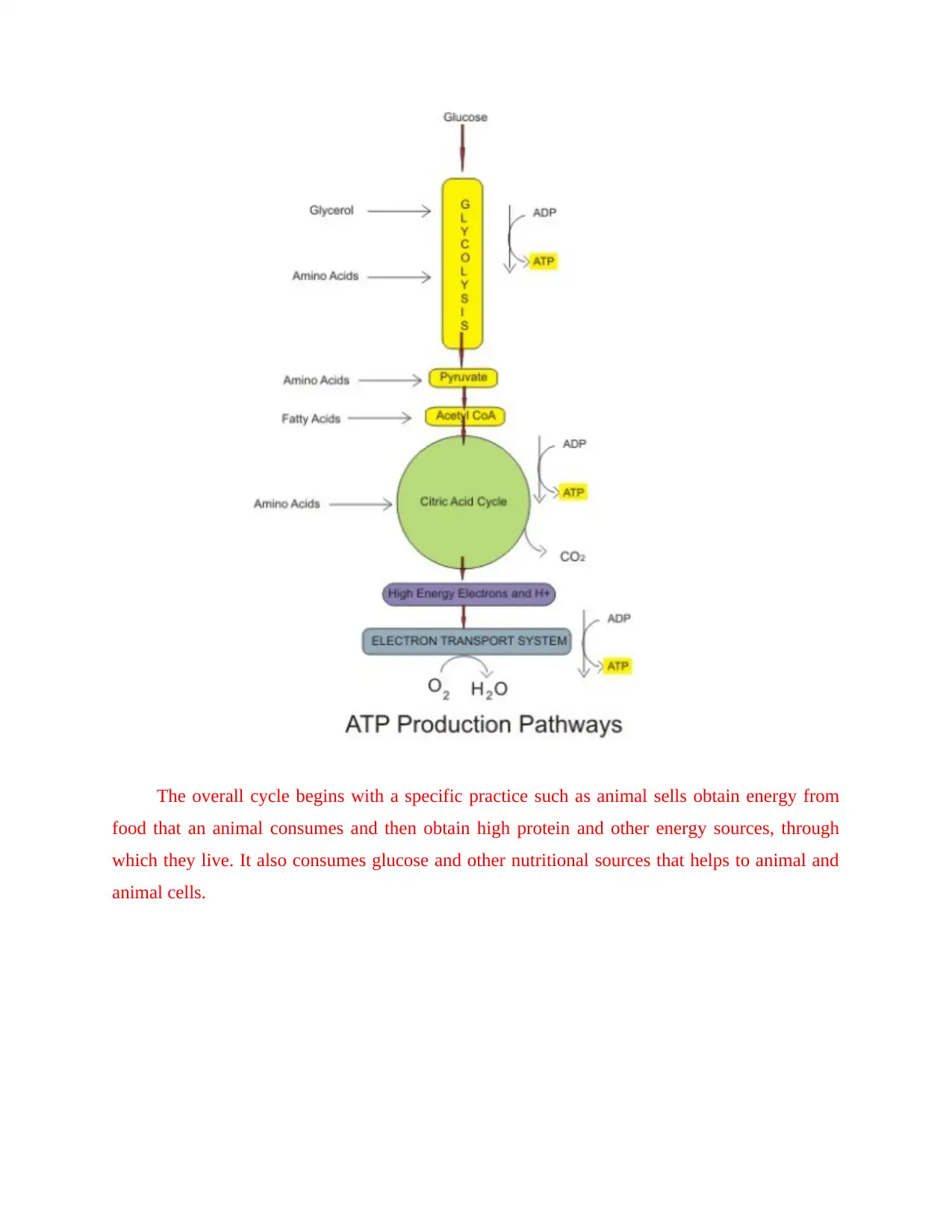
The overall cycle begins with a specific practice such as animal sells obtain energy from
food that an animal consumes and then obtain high protein and other energy sources, through
which they live. It also consumes glucose and other nutritional sources that helps to animal and
animal cells.
food that an animal consumes and then obtain high protein and other energy sources, through
which they live. It also consumes glucose and other nutritional sources that helps to animal and
animal cells.
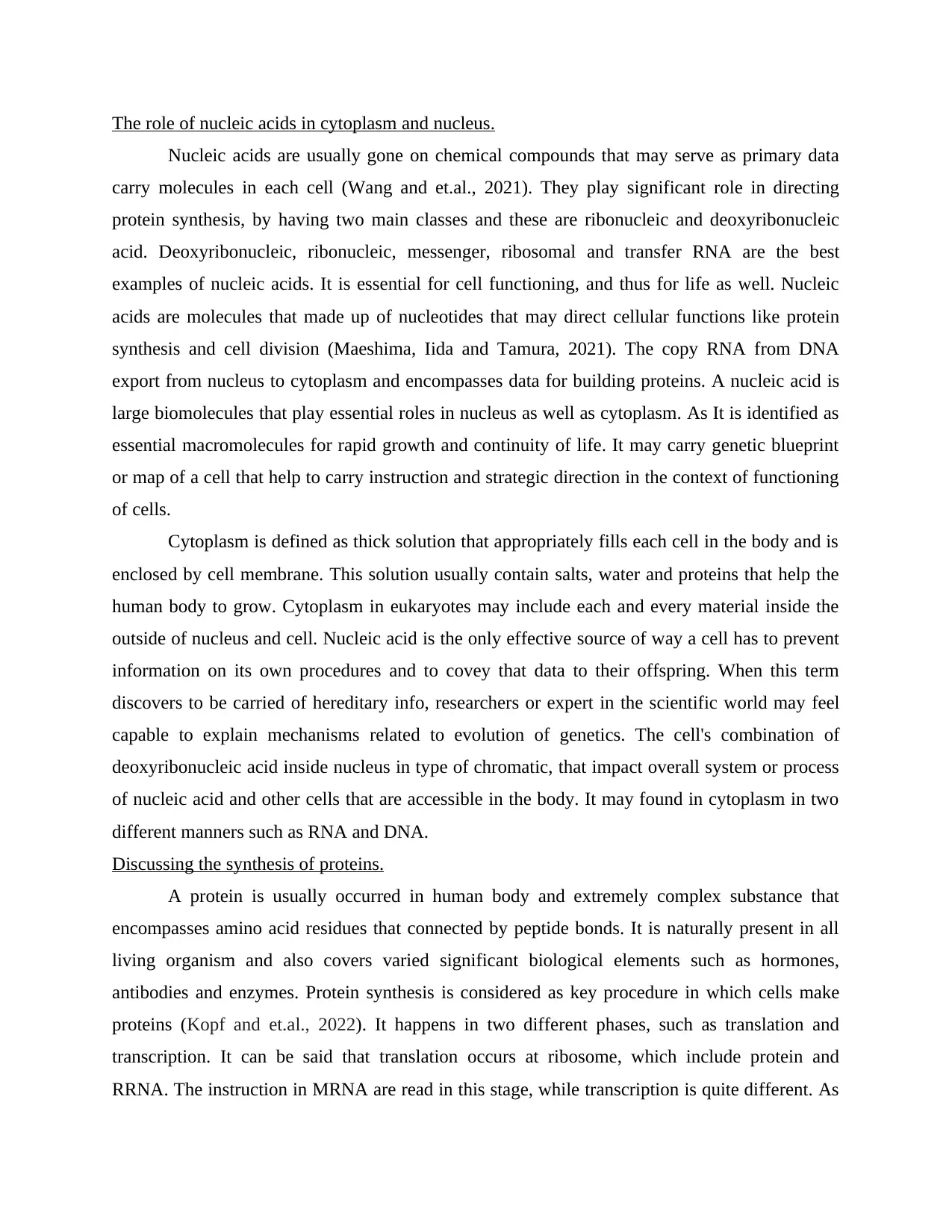
The role of nucleic acids in cytoplasm and nucleus.
Nucleic acids are usually gone on chemical compounds that may serve as primary data
carry molecules in each cell (Wang and et.al., 2021). They play significant role in directing
protein synthesis, by having two main classes and these are ribonucleic and deoxyribonucleic
acid. Deoxyribonucleic, ribonucleic, messenger, ribosomal and transfer RNA are the best
examples of nucleic acids. It is essential for cell functioning, and thus for life as well. Nucleic
acids are molecules that made up of nucleotides that may direct cellular functions like protein
synthesis and cell division (Maeshima, Iida and Tamura, 2021). The copy RNA from DNA
export from nucleus to cytoplasm and encompasses data for building proteins. A nucleic acid is
large biomolecules that play essential roles in nucleus as well as cytoplasm. As It is identified as
essential macromolecules for rapid growth and continuity of life. It may carry genetic blueprint
or map of a cell that help to carry instruction and strategic direction in the context of functioning
of cells.
Cytoplasm is defined as thick solution that appropriately fills each cell in the body and is
enclosed by cell membrane. This solution usually contain salts, water and proteins that help the
human body to grow. Cytoplasm in eukaryotes may include each and every material inside the
outside of nucleus and cell. Nucleic acid is the only effective source of way a cell has to prevent
information on its own procedures and to covey that data to their offspring. When this term
discovers to be carried of hereditary info, researchers or expert in the scientific world may feel
capable to explain mechanisms related to evolution of genetics. The cell's combination of
deoxyribonucleic acid inside nucleus in type of chromatic, that impact overall system or process
of nucleic acid and other cells that are accessible in the body. It may found in cytoplasm in two
different manners such as RNA and DNA.
Discussing the synthesis of proteins.
A protein is usually occurred in human body and extremely complex substance that
encompasses amino acid residues that connected by peptide bonds. It is naturally present in all
living organism and also covers varied significant biological elements such as hormones,
antibodies and enzymes. Protein synthesis is considered as key procedure in which cells make
proteins (Kopf and et.al., 2022). It happens in two different phases, such as translation and
transcription. It can be said that translation occurs at ribosome, which include protein and
RRNA. The instruction in MRNA are read in this stage, while transcription is quite different. As
Nucleic acids are usually gone on chemical compounds that may serve as primary data
carry molecules in each cell (Wang and et.al., 2021). They play significant role in directing
protein synthesis, by having two main classes and these are ribonucleic and deoxyribonucleic
acid. Deoxyribonucleic, ribonucleic, messenger, ribosomal and transfer RNA are the best
examples of nucleic acids. It is essential for cell functioning, and thus for life as well. Nucleic
acids are molecules that made up of nucleotides that may direct cellular functions like protein
synthesis and cell division (Maeshima, Iida and Tamura, 2021). The copy RNA from DNA
export from nucleus to cytoplasm and encompasses data for building proteins. A nucleic acid is
large biomolecules that play essential roles in nucleus as well as cytoplasm. As It is identified as
essential macromolecules for rapid growth and continuity of life. It may carry genetic blueprint
or map of a cell that help to carry instruction and strategic direction in the context of functioning
of cells.
Cytoplasm is defined as thick solution that appropriately fills each cell in the body and is
enclosed by cell membrane. This solution usually contain salts, water and proteins that help the
human body to grow. Cytoplasm in eukaryotes may include each and every material inside the
outside of nucleus and cell. Nucleic acid is the only effective source of way a cell has to prevent
information on its own procedures and to covey that data to their offspring. When this term
discovers to be carried of hereditary info, researchers or expert in the scientific world may feel
capable to explain mechanisms related to evolution of genetics. The cell's combination of
deoxyribonucleic acid inside nucleus in type of chromatic, that impact overall system or process
of nucleic acid and other cells that are accessible in the body. It may found in cytoplasm in two
different manners such as RNA and DNA.
Discussing the synthesis of proteins.
A protein is usually occurred in human body and extremely complex substance that
encompasses amino acid residues that connected by peptide bonds. It is naturally present in all
living organism and also covers varied significant biological elements such as hormones,
antibodies and enzymes. Protein synthesis is considered as key procedure in which cells make
proteins (Kopf and et.al., 2022). It happens in two different phases, such as translation and
transcription. It can be said that translation occurs at ribosome, which include protein and
RRNA. The instruction in MRNA are read in this stage, while transcription is quite different. As
⊘ This is a preview!⊘
Do you want full access?
Subscribe today to unlock all pages.

Trusted by 1+ million students worldwide
1 out of 23
Related Documents
Your All-in-One AI-Powered Toolkit for Academic Success.
+13062052269
info@desklib.com
Available 24*7 on WhatsApp / Email
![[object Object]](/_next/static/media/star-bottom.7253800d.svg)
Unlock your academic potential
Copyright © 2020–2025 A2Z Services. All Rights Reserved. Developed and managed by ZUCOL.




